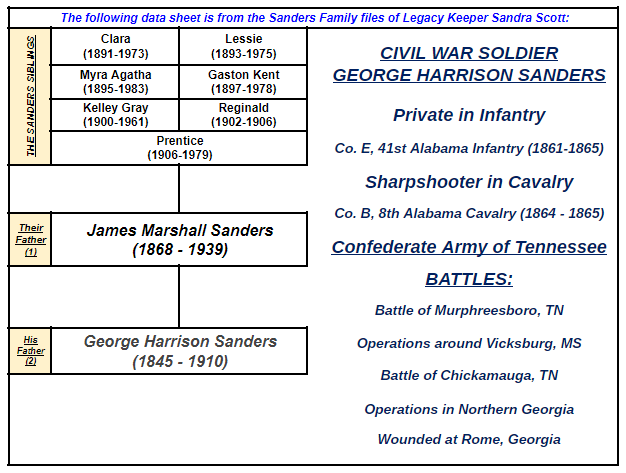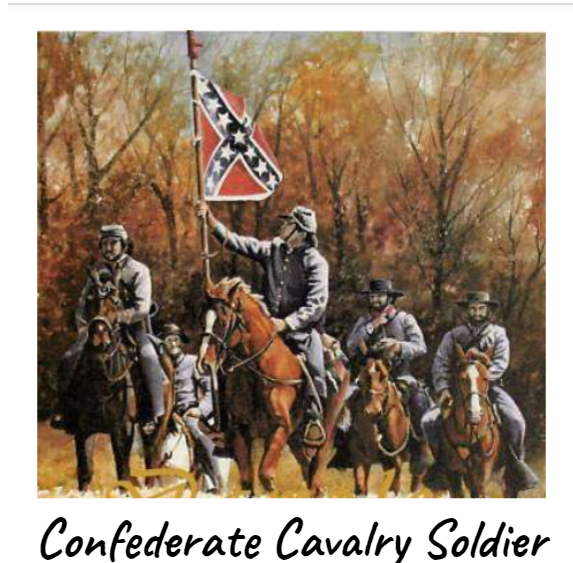

 The following is from the Sanders files of Legacy Keeper Janis McCoy:
The following is from the Sanders files of Legacy Keeper Janis McCoy:
George joined Co G, 41st Alabama Infantry, CSA, in Tuscaloosa, at the age of 16 and served two years,1 taking the place of one of his brothers. In 1863 [this would not have been two years – the 41st was not organized until May, 1862 – so he must have served in the 41st until about May of 1864] he reenlisted in Co. B, 8th Cavalry. He was discharged at Starkville, MS in May 1865.
According to the Sanders Family History, George served for his brother “Harvey Monroe Sanders, who was needed at home, or did not choose to go, but who did go later, anyway.”2 During the Civil War, as part of the 41st Regiment, George would probably have served in the Department of East Tennessee, attached to Hanson’s, Helm’s, and J. H. Lewis’ Brigade. He probably saw action in Murfreesboro during December 1862 – January 1863. Under the command of General Braxton Bragg, after being defeated at Perryville, KY (October 3, 1862) they:
“retreated, reorganized, and were redesignated as the Army of Tennessee. Then they advanced to Murfreesboro, Tennessee, and prepared to go into winter quarters. Maj. Gen. William S. Rosecrans’s Union Army of the Cumberland followed Bragg from Kentucky to Nashville. Rosecrans left Nashville on December 26, with about 44,000 men, to defeat Bragg’s army of more than 37,000. He found Bragg’s army on December 29 and went into camp that night, within hearing distance of the Rebels. At dawn on the 31st, Bragg’s men attacked the Union right flank. The Confederates had driven the Union line back to the Nashville Pike by 10:00 am but there it held. Union reinforcement arrived from Rosecran’s left in the late forenoon to bolster the stand, and before fighting stopped that day the Federals had established a new, strong line. On New Year’s Day, both armies marked time. Bragg surmised that Rosecrans would now withdraw, but the next morning he was still in position. In late afternoon, Bragg hurled a division at a Union division that, on January 1, had crossed Stone River and had taken up a strong position on the bluff east of the river. The Confederates drove most of the Federals back across McFadden’s Ford, but with the assistance of artillery, the Federals repulsed the attack, compelling the Rebels to retire, he claimed the victory. Stones River boosted Union morale. The Confederate had been thrown back in the east, west, and in the Trans-Mississippi.”3 The Confederate Army lost about 1,000 men at this battle.
At Vicksburg, George Sanders would have been part of the action, briefly described in this way:
“In May and June of 1863, Maj. Gen. Ulysses S. Grant’s armies converged on Vicksburg, investing the city and entrapping a Confederate army under Lt. Gen. John Pemberton. On July 4, Vicksburg surrendered after prolonged siege operations. This was the culmination of one of the most brilliant military campaigns of the war. With the loss of Pemberton’s army and this vital stronghold on the Mississippi, the Confederacy was effectively split in half. Grant’s successes in the West boosted his reputation, leading ultimately to his appointment as General-in-Chief of the Union armies.”4
The National Park Service describes the battle for Jackson in this way:
“On May 9, 1863, Gen. Joseph E. Johnston received a dispatch from the Confederate Secretary of War directing him to “proceed at once to Mississippi and take chief command of the forces in the field.” As he arrived in Jackson on the 13th, from Middle Tennessee, he learned that two army corps from the Union Army of the Tennessee-the XV, under Maj. Gen. William T. Sherman, and the XVII, under Maj. Gen. James Birdseye McPherson-were advancing on Jackson, intending to cut the city and the railroads off from Vicksburg. Johnston consulted with the local commander, Brig. Gen. John Gregg, and learned that only about 6,000 troops were available to defend the town. Johnston ordered the evacuation of Jackson, but Gregg was to defend Jackson until the evacuation was completed. By 10:00 am, both Union army corps were near Jackson and had engaged the enemy. Rain, Confederate resistance, and poor defenses prevented heavy fighting until around 11:00 am, when Union forces attacked in numbers and slowly but surely pushed the enemy back. In mid-afternoon, Johnston informed Gregg that the evacuation was complete and that he should disengage and follow. Soon after, the Yankees entered Jackson and had a celebration, hosted by Maj. Gen. U.S. Grant who had been travelling with Sherman’s corps, in the Bowman House. They then burned part of the town and cut the railroad connections with Vicksburg. Johnston’s evacuation of Jackson was a tragedy because he could, by late on the 14th, have had 11,000 troops at his disposal and by the morning of the 15th, another 4,000. The fall of the former Mississippi state capital was a blow to Confederate morale.”5
Most likely the last battle George probably served with the 41st Infantry was at Chickamauga, about which the Park Service provides the following information:
“After the Tullahoma Campaign, Rosecrans renewed his offensive, aiming to force the Confederates out of Chattanooga. The three army corps comprising Rosecrans’ s army split and set out for Chattanooga by separate routes. In early September, Rosecrans consolidated his forces scattered in Tennessee and Georgia and forced Bragg’s army out of Chattanooga, heading south. The Union troops followed it and brushed with it at Davis’ Cross Roads. Bragg was determined to reoccupy Chattanooga and decided to meet a part of Rosecrans’s army, defeat them, and then move back into the city. On the 17th he headed north, intending to meet and beat the XXI Army Corps. As Bragg marched north on the 18th, his cavalry and infantry fought with Union cavalry and mounted infantry which were armed with Spencer repeating rifles. Fighting began in earnest on the morning of the 19th, and Bragg’s men hammered but did not break the Union line. The next day, Bragg continued his assault on the Union line on the left, and in late morning, Rosecrans was informed that he had a gap in his line. In moving units to shore up the supposed gap, Rosecrans created one, and James Longstreet’s men promptly exploited it, driving one-third of the Union army, including Rosecrans himself, from the field. George H. Thomas took over command and began consolidating forces on Horseshoe Ridge and Snodgrass Hill. Although the Rebels launched determined assaults on these forces, they held until after dark. Thomas then led these men from the field leaving it to the Confederates. The Union retired to Chattanooga while the Rebels occupied the surrounding heights.”6
In the fall of 1863, perhaps after the brother for whom he was serving decided to join up, George ” deserted” the 41st Alabama and re-enlisted as a private in Co. B, 8th Cavalry (commanded by Col. Charles P. Ball, which was organized in April, 1864.7
The National Park Service has available information on the activities of the 8th Calvary. But according to the Alabama Department of Archives:
“This regiment was organized in April 1864 at Newbern, by adding a company to the nine of Hatch’s battalion, which had entered the service the previous winter. Ordered at once to Blue Mountain, the regiment was under General Pillow. Moving into north Georgia, the regiment was in the desperate encounter at Lafayette, with a loss of 30 killed and wounded and about 75 prisoners. Shortly after, the Eighth fought at Rome, losing about 20 men killed and wounded. It was ordered to west Florida soon after, and was in front of Steele as he moved on Pollard. The Eighth surrendered at Gainesville, after some further operations of minor importance.”8
Even after being wounded George, according to notations in his war report found in the National Archives, Washington, D.C. stated he “Continued after much service and often Gen. Joe Wheeler,” that he “Served on special detail as a Sharp Shooter.”9
The Sanders Family History tells how George’s military career ended:
“According to an “Application for the Relief of Confederate Soldiers and Sailors” that George filed in June, 1899 at the age of 54, he was wounded at the battle of Rome, GA, and was unable to make a living by manual labor on account of ‘said wound and shot in the arm and Abdom. =Rim of Abdomon broke all around.’) George was with the 8th Ala. Cavalry when it surrendered at Gainesville, FL on 4 May 1865, and he was ‘paroled’ (discharged) at Starkville, MS that same month.”10
________________________________________________________________________________
1 www.fold3.com/image/#304578413, www.fold3.com/image/#12108636, and picture of tombstone
2 Sanders Family History, draft, unpublished, page 21
3 https://www.nps.gov/civilwar/search-battles-detail.htm?battleCode=tn010
4 https://www.nps.gov/civilwar/search-battles-detail.htm?battleCode=ms010
5 https://www.nps.gov/civilwar/search-battles-detail.htm?battleCode=ms008
6 https://www.nps.gov/civilwar/search-battles-detail.htm?battleCode=ga004
7 Sanders Family History, draft, unpublished, page 21
8 http://www.archives.state.al.us/agis.html
9 Sanders Family History, draft, unpublished, page 22
10 Sanders Family History, draft, unpublished, page 22

